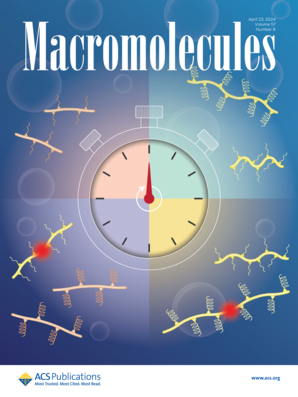Cationic Dithiocarbamate for Efficient Blue Light-Controlled Photoiniferter Polymerization
IF 5.1
1区 化学
Q1 POLYMER SCIENCE
引用次数: 0
Abstract
N-phenyl-N-pyridin-1-ium dithiocarbamate was developed as a versatile iniferter for blue light-controlled radical polymerization. Tunable solubility in both water and various organic solvents was achieved through counterion exchange (Br– or PF6–). UV–visible absorption spectroscopy revealed strong blue light absorption. Kinetic studies for the photoiniferter polymerization of various monomers conducted using the dithiocarbamate in comparison with other iniferters revealed a combination of faster polymerization rates, shorter induction periods, and good control over molecular weights and molecular weight distributions. Electron paramagnetic resonance (EPR) studies demonstrated a faster photolysis rate for the dithiocarbamate compared to a trithiocarbonate iniferter. Photoiniferter polymerizations were conducted for N,N-dimethylacrylamide, N-acryloylmorpholine, methyl acrylate, poly(ethylene glycol) methyl ether acrylate (Mn = 480 g mol–1), and N,N-dimethyl lactamide acrylate in various solvents using the dithiocarbamate iniferter, yielding the corresponding homopolymers with controlled molecular weights (up to an Mn of 1316.8 kg mol–1) and narrow dispersities. High end-group fidelity was confirmed by 1H NMR spectroscopy and matrix-assisted laser desorption ionization time-of-flight (MALDI-TOF) mass spectrometry, enabling one-pot synthesis of well-defined diblock copolymers. Combining rapid kinetics, solvent versatility, and no requirement for acid additives, this system offers an accessible platform for precision polymer synthesis under mild, visible-light conditions.

阳离子二硫代氨基甲酸酯用于高效蓝光控制光干扰素聚合
n-苯基- n-吡啶-1-二硫代氨基甲酸铵是一种用于蓝光控制自由基聚合的多用途干扰素。通过反离子交换(Br -或PF6 -)实现了在水和各种有机溶剂中的可调溶解度。紫外可见吸收光谱显示对蓝光有较强的吸收。利用二硫代氨基甲酸酯对各种单体进行光干扰聚合的动力学研究,并与其他干扰物进行了比较,结果表明,二硫代氨基甲酸酯具有更快的聚合速率、更短的诱导周期以及对分子量和分子量分布的良好控制。电子顺磁共振(EPR)研究表明,与三硫代碳酸盐干扰素相比,二硫代碳酸盐的光解速率更快。利用二硫代氨基甲酸酯干扰素在不同溶剂中对N,N-二甲基丙烯酰胺、N-丙烯酰啉、丙烯酸甲酯、聚乙二醇甲基醚丙烯酸酯(Mn = 480 g mol-1)和N,N-二甲基内酰胺丙烯酸酯进行了光干扰素聚合,得到了相应的分子量可控(Mn为1316.8 kg mol-1)且分散度窄的均聚物。1H NMR谱和基质辅助激光解吸电离飞行时间(MALDI-TOF)质谱证实了高端基保真度,使一锅合成具有良好定义的二嵌段共聚物成为可能。该系统结合了快速动力学、溶剂通用性和不需要酸添加剂,为在温和的可见光条件下进行精密聚合物合成提供了一个可访问的平台。
本文章由计算机程序翻译,如有差异,请以英文原文为准。
求助全文
约1分钟内获得全文
求助全文
来源期刊

Macromolecules
工程技术-高分子科学
CiteScore
9.30
自引率
16.40%
发文量
942
审稿时长
2 months
期刊介绍:
Macromolecules publishes original, fundamental, and impactful research on all aspects of polymer science. Topics of interest include synthesis (e.g., controlled polymerizations, polymerization catalysis, post polymerization modification, new monomer structures and polymer architectures, and polymerization mechanisms/kinetics analysis); phase behavior, thermodynamics, dynamic, and ordering/disordering phenomena (e.g., self-assembly, gelation, crystallization, solution/melt/solid-state characteristics); structure and properties (e.g., mechanical and rheological properties, surface/interfacial characteristics, electronic and transport properties); new state of the art characterization (e.g., spectroscopy, scattering, microscopy, rheology), simulation (e.g., Monte Carlo, molecular dynamics, multi-scale/coarse-grained modeling), and theoretical methods. Renewable/sustainable polymers, polymer networks, responsive polymers, electro-, magneto- and opto-active macromolecules, inorganic polymers, charge-transporting polymers (ion-containing, semiconducting, and conducting), nanostructured polymers, and polymer composites are also of interest. Typical papers published in Macromolecules showcase important and innovative concepts, experimental methods/observations, and theoretical/computational approaches that demonstrate a fundamental advance in the understanding of polymers.
 求助内容:
求助内容: 应助结果提醒方式:
应助结果提醒方式:


